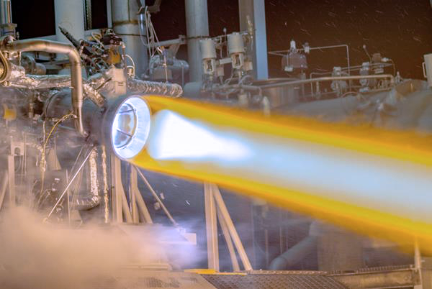
Aerojet Rocketdyne (NYSE:AJRD) has successfully hot-fire tested a full-scale, additively manufactured thrust chamber assembly for the RL10 rocket engine that was built from a copper alloy using selective laser melting (SLM) technology, which is often referred to as 3-D printing.

Aerojet Rocketdyne recently completed successful hot-fire testing of a full-scale, additively manufactured thrust chamber assembly for the RL10 rocket engine at its West Palm Beach, Florida facility.
Photo is courtesy of Aerojet Rocketdyne.
The company has actively been working over the last decade to incorporate 3-D printing technology into the RL10 and other propulsion systems to make them more affordable while taking advantage of the inherent design and performance capabilities made possible by 3-D printing. This recent testing was enabled by the Defense Production Act Title III program management office located at Wright-Patterson Air Force Base near Dayton, Ohio.
The 3-D printed RL10 copper thrust chamber would replace the current RL10C-1 model design that uses a very complex array of drawn, hydroformed stainless steel tubes that are brazed together to form a thrust chamber. The new chamber design is made up of only two primary copper parts and takes just under a month to print using SLM technology; reducing overall lead time by several months. The part count reduction of greater than 90 percent is significant as it reduces complexity and cost when compared with RL10 thrust chambers that are built today using traditional manufacturing techniques.
Another key benefit provided by 3-D printing is the ability to design and build advanced features that allow for improved heat transfer. For many rocket engine applications, this enhanced heat transfer capability enables a more compact and lighter engine, which is highly desirable in space launch applications.
Aerojet Rocketdyne is applying 3-D printing technology to many of its other products, including the RS-25 engines that will help explore deep space, and the company’s new AR1 booster engine that is being developed to replace Russian-built RD-180 engines by the congressionally-mandated deadline of 2019. Since its first operational flight in 1963, more than 475 RL10 engines have flown in space to help place numerous spacecraft into Earth orbit and propel others to explore every planet in our solar system.
The company's Additive Manufacturing Program Manager, Jeff Haynes, reported that the firm believes this is the largest copper-alloy thrust chamber ever built with 3-D printing and successfully tested. Producing aerospace-quality components with additive manufacturing is challenging. Producing them with a high-thermal-conductivity copper alloy using SLM technology is even more difficult. Infusing this technology into full-scale rocket engines is truly transformative as it opens up new design possibilities for our engineers and paves the way for a new generation of low-cost rocket engines.

